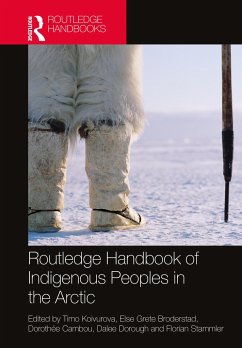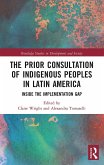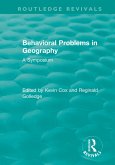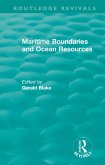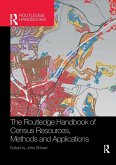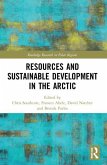Routledge Handbook of Indigenous Peoples in the Arctic
Herausgeber: Koivurova, Timo; Cambou, Dorothée; Broderstad, Else Grete
Routledge Handbook of Indigenous Peoples in the Arctic
Herausgeber: Koivurova, Timo; Cambou, Dorothée; Broderstad, Else Grete
- Broschiertes Buch
- Merkliste
- Auf die Merkliste
- Bewerten Bewerten
- Teilen
- Produkt teilen
- Produkterinnerung
- Produkterinnerung
This handbook brings together the expertise of Indigenous and non-Indigenous scholars to offer a comprehensive overview of issues surrounding the well-being, self-determination and sustainability of Indigenous peoples in the Arctic.
Andere Kunden interessierten sich auch für
![The Prior Consultation of Indigenous Peoples in Latin America The Prior Consultation of Indigenous Peoples in Latin America]() The Prior Consultation of Indigenous Peoples in Latin America64,99 €
The Prior Consultation of Indigenous Peoples in Latin America64,99 €![The Big Smoke (Routledge Revivals) The Big Smoke (Routledge Revivals)]() Peter BrimblecombeThe Big Smoke (Routledge Revivals)60,99 €
Peter BrimblecombeThe Big Smoke (Routledge Revivals)60,99 €![Routledge Revivals Routledge Revivals]() Kevin CoxRoutledge Revivals53,99 €
Kevin CoxRoutledge Revivals53,99 €![Routledge Revivals Routledge Revivals]() Routledge Revivals54,99 €
Routledge Revivals54,99 €![The World and Its Peoples Photographed and Described: a Political, Geographical, Social, and Commercial History of the Various Countries of the World The World and Its Peoples Photographed and Described: a Political, Geographical, Social, and Commercial History of the Various Countries of the World]() The World and Its Peoples Photographed and Described: a Political, Geographical, Social, and Commercial History of the Various Countries of the World29,99 €
The World and Its Peoples Photographed and Described: a Political, Geographical, Social, and Commercial History of the Various Countries of the World29,99 €![The Routledge Handbook of Census Resources, Methods and Applications The Routledge Handbook of Census Resources, Methods and Applications]() The Routledge Handbook of Census Resources, Methods and Applications65,99 €
The Routledge Handbook of Census Resources, Methods and Applications65,99 €![Resources and Sustainable Development in the Arctic Resources and Sustainable Development in the Arctic]() Resources and Sustainable Development in the Arctic64,99 €
Resources and Sustainable Development in the Arctic64,99 €-
-
-
This handbook brings together the expertise of Indigenous and non-Indigenous scholars to offer a comprehensive overview of issues surrounding the well-being, self-determination and sustainability of Indigenous peoples in the Arctic.
Hinweis: Dieser Artikel kann nur an eine deutsche Lieferadresse ausgeliefert werden.
Hinweis: Dieser Artikel kann nur an eine deutsche Lieferadresse ausgeliefert werden.
Produktdetails
- Produktdetails
- Verlag: Routledge
- Seitenzahl: 404
- Erscheinungstermin: 4. Dezember 2020
- Englisch
- Abmessung: 246mm x 174mm x 22mm
- Gewicht: 717g
- ISBN-13: 9780367220396
- ISBN-10: 0367220393
- Artikelnr.: 69939368
- Herstellerkennzeichnung
- Libri GmbH
- Europaallee 1
- 36244 Bad Hersfeld
- gpsr@libri.de
- Verlag: Routledge
- Seitenzahl: 404
- Erscheinungstermin: 4. Dezember 2020
- Englisch
- Abmessung: 246mm x 174mm x 22mm
- Gewicht: 717g
- ISBN-13: 9780367220396
- ISBN-10: 0367220393
- Artikelnr.: 69939368
- Herstellerkennzeichnung
- Libri GmbH
- Europaallee 1
- 36244 Bad Hersfeld
- gpsr@libri.de
Timo Koivurova is Research Professor and Director at the Arctic Centre, University of Lapland. He has a multidisciplinary specialisation in Arctic law and government but has also conducted broader research on global law. Else Grete Broderstad is Professor in Indigenous Studies and coordinates the Indigenous Master Programme, UiT, The Arctic University of Norway. Her research areas include Indigenous rights, political participation, governance of the Circumpolar North, resource management and conflicting interests between Indigenous traditional livelihoods and large-scale industries. Dorothée Cambou is Assistant Professor in sustainability science at the faculty of law, HELSUS, University of Helsinki. Her research focuses on the rights of Indigenous peoples and the governance of land and natural resources in the Arctic and the Global South. Dalee Dorough, an Inuk from Alaska, is Senior Scholar and Special Advisor on Indigenous Peoples in the Arctic, UAA. Specializing in international Indigenous human rights, she holds a PhD in law bestowed by University of British Columbia in 2002 and Master of Arts in law and diplomacy from The Fletcher School in 1991. Florian Stammler is Coordinator of Anthropology and Research Professor at the Arctic Centre, University of Lapland. His research is on nomadism, human-environment relations, Indigenous peoples and extractive industries. His publications include Reindeer Nomads Meet the Market and Good to Eat, Good to Live With.
SECTION 1 Arctic Indigenous diversity and the foundations of cultural,
social and spiritual well-being 1. The role of statistics in relation to
Arctic Indigenous realities 2. Indigenizing education in Sapmi/Norway:
rights, interface and the pedagogies of discomfort and hope 3. What makes a
good political leader? Young people's perceptions from the republic of
Sakha (Yakutia) 4. Electronic devices for safeguarding Indigenous languages
and cultures (Eastern Siberia) 5. Voices of the forests, voices of the
streets: popular music and modernist transformation in Sakha (Yakutia),
Northeast Siberia 6. Soviet-time Indigenous displacement on the Kola
Peninsula: an extreme case of a common practice 7. Indigenous Arctic
religions SECTION 2 The fundamental importance of land, territories and
resources 8. Changing Indigenous territorial rights in the Russian North 9.
Sami law and rights in Norway - with a focus on recent developments 10.
Comprehending the mandate and interactions of land tenure reform in
Finnmark, Norway 11. The Girjas Case - court proceedings as a strategy to
enforce Sami land rights 12. Arctic waters as Inuit homeland 13. Alaska
Native marine mammal harvesting: the Marine Mammal Protection Act and the
crisis of eligibility 14. Review and mapping of Indigenous knowledge
concepts in the Arctic SECTION 3 Indigenous peoples and self-determination
in the Arctic 15. Indigenous self-government in the Arctic: assessing the
scope and legitimacy in Nunavut, Greenland and Sapmi 16. Advancing Inuit
self-determination and governance in Alaska and Canada amidst renewed
global focus on the Arctic 17. Indigenous peoples' right to
self-determination: perceptions of self-determination among the Sami
electorate in Sweden 18. Indigenous self-determination and disempowerment
in the Russian North 19. The participation of Arctic Indigenous peoples'
organizations in the Arctic Council and beyond 20. Legal appraisal of
Arctic Indigenous peoples' right to free, prior and informed consent
Epilogue: Alaska natives and climate change
social and spiritual well-being 1. The role of statistics in relation to
Arctic Indigenous realities 2. Indigenizing education in Sapmi/Norway:
rights, interface and the pedagogies of discomfort and hope 3. What makes a
good political leader? Young people's perceptions from the republic of
Sakha (Yakutia) 4. Electronic devices for safeguarding Indigenous languages
and cultures (Eastern Siberia) 5. Voices of the forests, voices of the
streets: popular music and modernist transformation in Sakha (Yakutia),
Northeast Siberia 6. Soviet-time Indigenous displacement on the Kola
Peninsula: an extreme case of a common practice 7. Indigenous Arctic
religions SECTION 2 The fundamental importance of land, territories and
resources 8. Changing Indigenous territorial rights in the Russian North 9.
Sami law and rights in Norway - with a focus on recent developments 10.
Comprehending the mandate and interactions of land tenure reform in
Finnmark, Norway 11. The Girjas Case - court proceedings as a strategy to
enforce Sami land rights 12. Arctic waters as Inuit homeland 13. Alaska
Native marine mammal harvesting: the Marine Mammal Protection Act and the
crisis of eligibility 14. Review and mapping of Indigenous knowledge
concepts in the Arctic SECTION 3 Indigenous peoples and self-determination
in the Arctic 15. Indigenous self-government in the Arctic: assessing the
scope and legitimacy in Nunavut, Greenland and Sapmi 16. Advancing Inuit
self-determination and governance in Alaska and Canada amidst renewed
global focus on the Arctic 17. Indigenous peoples' right to
self-determination: perceptions of self-determination among the Sami
electorate in Sweden 18. Indigenous self-determination and disempowerment
in the Russian North 19. The participation of Arctic Indigenous peoples'
organizations in the Arctic Council and beyond 20. Legal appraisal of
Arctic Indigenous peoples' right to free, prior and informed consent
Epilogue: Alaska natives and climate change
SECTION 1 Arctic Indigenous diversity and the foundations of cultural,
social and spiritual well-being 1. The role of statistics in relation to
Arctic Indigenous realities 2. Indigenizing education in Sapmi/Norway:
rights, interface and the pedagogies of discomfort and hope 3. What makes a
good political leader? Young people's perceptions from the republic of
Sakha (Yakutia) 4. Electronic devices for safeguarding Indigenous languages
and cultures (Eastern Siberia) 5. Voices of the forests, voices of the
streets: popular music and modernist transformation in Sakha (Yakutia),
Northeast Siberia 6. Soviet-time Indigenous displacement on the Kola
Peninsula: an extreme case of a common practice 7. Indigenous Arctic
religions SECTION 2 The fundamental importance of land, territories and
resources 8. Changing Indigenous territorial rights in the Russian North 9.
Sami law and rights in Norway - with a focus on recent developments 10.
Comprehending the mandate and interactions of land tenure reform in
Finnmark, Norway 11. The Girjas Case - court proceedings as a strategy to
enforce Sami land rights 12. Arctic waters as Inuit homeland 13. Alaska
Native marine mammal harvesting: the Marine Mammal Protection Act and the
crisis of eligibility 14. Review and mapping of Indigenous knowledge
concepts in the Arctic SECTION 3 Indigenous peoples and self-determination
in the Arctic 15. Indigenous self-government in the Arctic: assessing the
scope and legitimacy in Nunavut, Greenland and Sapmi 16. Advancing Inuit
self-determination and governance in Alaska and Canada amidst renewed
global focus on the Arctic 17. Indigenous peoples' right to
self-determination: perceptions of self-determination among the Sami
electorate in Sweden 18. Indigenous self-determination and disempowerment
in the Russian North 19. The participation of Arctic Indigenous peoples'
organizations in the Arctic Council and beyond 20. Legal appraisal of
Arctic Indigenous peoples' right to free, prior and informed consent
Epilogue: Alaska natives and climate change
social and spiritual well-being 1. The role of statistics in relation to
Arctic Indigenous realities 2. Indigenizing education in Sapmi/Norway:
rights, interface and the pedagogies of discomfort and hope 3. What makes a
good political leader? Young people's perceptions from the republic of
Sakha (Yakutia) 4. Electronic devices for safeguarding Indigenous languages
and cultures (Eastern Siberia) 5. Voices of the forests, voices of the
streets: popular music and modernist transformation in Sakha (Yakutia),
Northeast Siberia 6. Soviet-time Indigenous displacement on the Kola
Peninsula: an extreme case of a common practice 7. Indigenous Arctic
religions SECTION 2 The fundamental importance of land, territories and
resources 8. Changing Indigenous territorial rights in the Russian North 9.
Sami law and rights in Norway - with a focus on recent developments 10.
Comprehending the mandate and interactions of land tenure reform in
Finnmark, Norway 11. The Girjas Case - court proceedings as a strategy to
enforce Sami land rights 12. Arctic waters as Inuit homeland 13. Alaska
Native marine mammal harvesting: the Marine Mammal Protection Act and the
crisis of eligibility 14. Review and mapping of Indigenous knowledge
concepts in the Arctic SECTION 3 Indigenous peoples and self-determination
in the Arctic 15. Indigenous self-government in the Arctic: assessing the
scope and legitimacy in Nunavut, Greenland and Sapmi 16. Advancing Inuit
self-determination and governance in Alaska and Canada amidst renewed
global focus on the Arctic 17. Indigenous peoples' right to
self-determination: perceptions of self-determination among the Sami
electorate in Sweden 18. Indigenous self-determination and disempowerment
in the Russian North 19. The participation of Arctic Indigenous peoples'
organizations in the Arctic Council and beyond 20. Legal appraisal of
Arctic Indigenous peoples' right to free, prior and informed consent
Epilogue: Alaska natives and climate change

